
The Caridea, commonly known as caridean shrimp or true shrimp, from the Greek word καρίς, καρίδος, are an infraorder of shrimp within the order Decapoda. This infraorder contains all species of true shrimp. They are found widely around the world in both fresh and salt water. Many other animals with similar names – such as the mud shrimp of Axiidea and the boxer shrimp of Stenopodidea – are not true shrimp, but many have evolved features similar to true shrimp.

The Decapoda or decapods are an order of crustaceans within the class Malacostraca, and includes crabs, lobsters, crayfish, shrimp, and prawns. Most decapods are scavengers. The order is estimated to contain nearly 15,000 extant species in around 2,700 genera, with around 3,300 fossil species. Nearly half of these species are crabs, with the shrimp and Anomura including hermit crabs, porcelain crabs, squat lobsters making up the bulk of the remainder. The earliest fossils of the group date to the Devonian.

The Stenopodidea or boxer shrimps are a small group of decapod crustaceans. Often confused with Caridea shrimp or Dendrobranchiata prawns, they are neither, belonging to their own group.
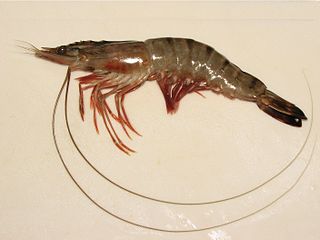
Penaeidae is a family of marine crustaceans in the suborder Dendrobranchiata, which are often referred to as penaeid shrimp or penaeid prawns. The Penaeidae contain many species of economic importance, such as the tiger prawn, whiteleg shrimp, Atlantic white shrimp, and Indian prawn. Many prawns are the subject of commercial fishery, and farming, both in marine settings, and in freshwater farms. Lateral line–like sense organs on the antennae have been reported in some species of Penaeidae. At 210 metres per second (760 km/h), the myelinated giant interneurons of pelagic penaeid shrimp have the world record for impulse conduction speed in any animal.

Axiidea is an infraorder of decapod crustaceans. They are colloquially known as mud shrimp, ghost shrimp, or burrowing shrimp; however, these decapods are only distantly related to true shrimp. Axiidea and Gebiidea are divergent infraoders of the former infraorder Thalassinidea. These infraorders have converged ecologically and morphologically as burrowing forms. Based on molecular evidence as of 2009, it is now widely believed that these two infraorders represent two distinct lineages separate from one another. Since this is a recent change, much of the literature and research surrounding these infraorders still refers to the Axiidea and Gebiidea in combination as "thalassinidean" for the sake of clarity and reference. This division based on molecular evidence is consistent with the groupings proposed by Robert Gurney in 1938 based on larval developmental stages.
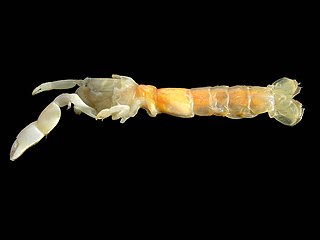
Callianassidae is a family of ghost shrimp crustaceans belonging to the infraorder Axiidea, within the order Decapoda.
Callianassa is a genus of mud shrimps, in the family Callianassidae. Three of the species in this genus have been split off into a new genus, Pestarella, while others such as Callianassa filholi have been moved to Biffarius. The genus is named after the Nereid of the Greco-Roman mythology.
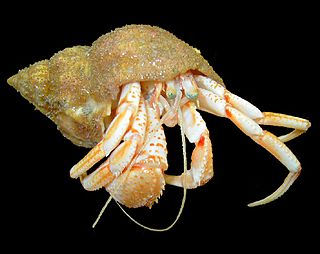
The Paguridae are a family of hermit crabs of the order Decapoda. The king crabs, Lithodidae, are now widely understood to be derived from deep within the Paguridae, with some authors placing their ancestors within the genus Pagurus.

Sergestidae is a family of prawns which have lived since at least the Middle Jurassic (Bajocian/Bathonian). It contains the following genera:
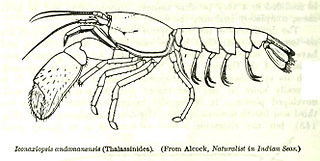
Eiconaxius is a genus of mud lobster that includes the following species:

Acanthochirana is an extinct genus of prawn that existed during the upper Jurassic period. It was named by E. Strand in 1928, and its type species is Acanthochirana cordata. They are distinguished from the related genus Aeger by the presence of teeth on the rostrum, which are absent in Aeger.
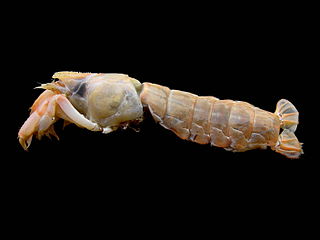
Gebiidea is an infraorder of decapod crustaceans. Gebiidea and Axiidea are divergent infraoders of the former infraorder Thalassinidea. These infraorders have converged ecologically and morphologically as burrowing forms. Based on molecular evidence as of 2009, it is now widely believed that these two infraorders represent two distinct lineages separate from one another. Since this is a recent change, much of the literature and research surrounding these infraorders still refers to the Axiidea and Gebiidea in combination as "thalassinidean" for the sake of clarity and reference. This division based on molecular evidence is consistent with the groupings proposed by Robert Gurney in 1938 based on larval developmental stages.
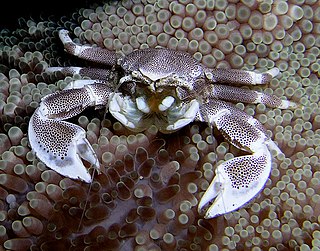
The Galatheoidea are a superfamily of decapod crustaceans comprising the porcelain crabs and some squat lobsters. Squat lobsters within the three families of the superfamily Chirostyloidea are not closely related to the squat lobsters within the Galatheoidea. The fossil record of the superfamily extends back to the Middle Jurassic genus Palaeomunidopsis.

Dorphinaxius kermadecensis is a species of mud lobster native to the Norfolk Island, parts of New South Wales, and the Kermadec Islands of New Zealand. It is the only species in the genus Dorphinaxius. It has a depth range of 0–8 metres (0–26 ft).

Acanthaxius is a genus of mud lobster native to the Indo-Pacific oceans. It has a slender rostrum which is longer than the eyestalks, is spinose and has seven spines and has a depth range of 228–438 metres (748–1,437 ft).
Gourretiidae is a family of crustaceans belonging to the infraorder Axiidea, within the order Decapoda.

Laomediidae is a family of mud shrimp crustaceans belonging to the infraorder Gebiidea, within the order Decapoda.
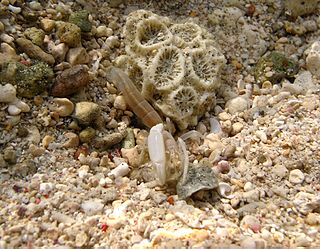
Callianideidae is a family of crustaceans belonging to the infraorder Axiidea, within the order Decapoda.

Micheleidae is a family of crustaceans belonging to the infraorder Axiidea, within the order Decapoda.
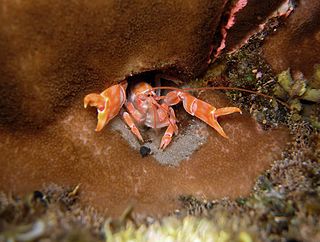
Strahlaxiidae is a family of crustaceans belonging to the infraorder Axiidea, within the order Decapoda.

















